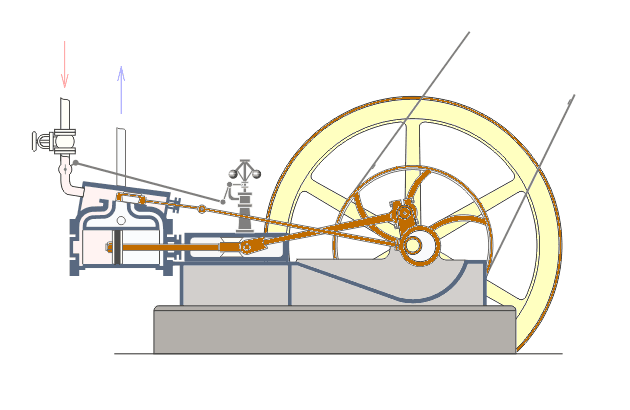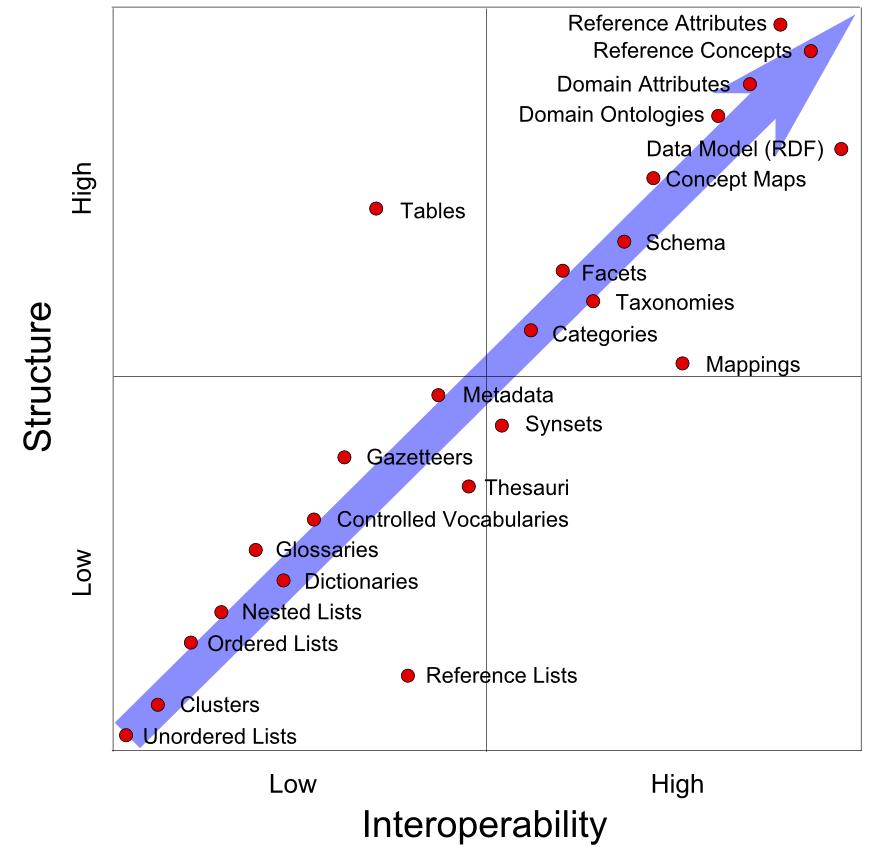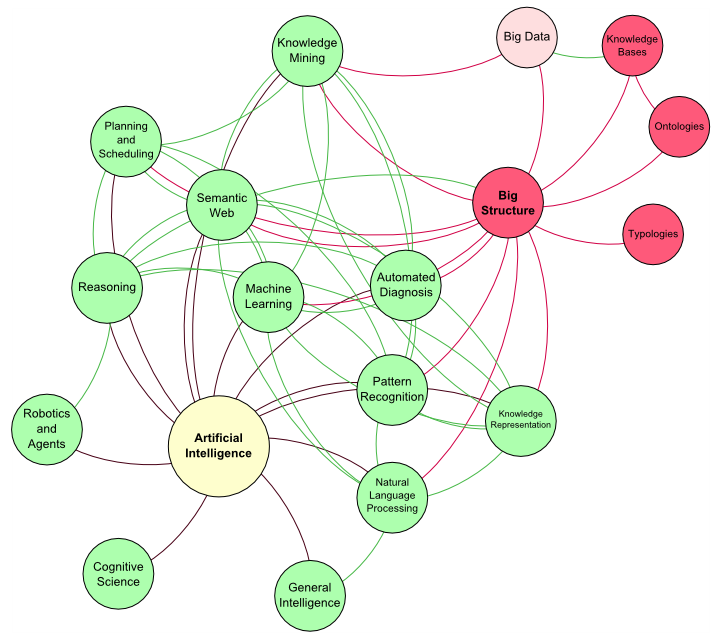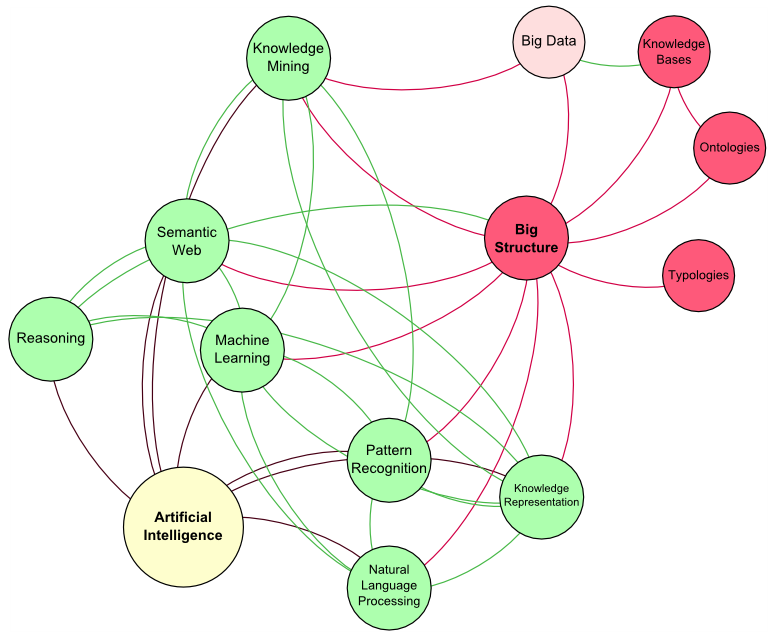 A Critical Fit with the Semantic Web and AI
A Critical Fit with the Semantic Web and AI
In the first parts of this series we introduced the idea of Big Structure, and the fact that it resides at the nexus of the semantic Web, artificial intelligence, natural language processing, knowledge bases, and Big Data. In this article, we look specifically at the work that Big Structure promotes in data interoperability as a way to clarify what the roles these various aspects play.
By its nature, data integration (the first step in data interoperability) means that data is being combined across two or more datasets. Such integration surfaces all of the myriad aspects of semantic heterogeneities, exactly the kinds of issues that the semantic Web and semantic technologies were designed to address. But resolving semantic differences can not be fulfilled by semantic technologies alone. While semantics can address the basis of differences in meaning and context, resolution of those differences or deciding between differing interpretations (that is, ambiguity) also requires many of the tools of artificial intelligence or natural language processing (NLP).
By decomposing this space into its various sources of semantic heterogeneities — as well as the work required in order to provide for such functions as search, disambiguation, mapping and transformations — we can begin to understand how all of these components can work together in order to help achieve data interoperability. This understanding, in turn, is essential to understand the stack and software architecture — and its accompanying information architecture — in order to best achieve these interoperability objectives.
So, this current article lays out this conceptual framework of components and roles. Later articles in this series will address the specific questions of software and information architectural design.
Data Interoperability in Relation to Semantics
Semantic technologies give us the basis for understanding differences in meaning across sources, specifically geared to address differences in real world usage and context. These semantic tools are essential for providing common bases for relating structured data across various sources and contexts. These same semantic tools are also the basis by which we can determine what unstructured content “means”, thus providing the structured data tags that also enable us to relate documents to conventional data sources (from databases, spreadsheets, tables and the like). These semantic technologies are thus the key enablers for making information — unstructured, semi-structured and structured — understandable to both humans and machines across sources. Such understandings are then a key basis for powering the artificial intelligence applications that are now emerging to make our lives more productive and less routine.
For nearly a decade I have used an initial schema by Pluempitiwiriyawej and Hammer to elucidate the sources of possible semantic differences between content. Over the years I have added language and encoding differences to this schema. Most recently, I have updated this schema to specifically call out semantic heterogeneities due to either conceptual differences between sources (largely arising from schema differences) and value and attribute differences amongst actual data. I have further added examples for what each of these categories of semantic heterogenities means [1].
This table of more than 40 sources of semantic heterogeneities clearly shows the possible impediments to get data to interoperate across sources:
| Class | Category | Subcategory | Examples | Type [2] [4] |
| LANGUAGE | Encoding | Ingest Encoding Mismatch | For example, ANSI v UTF-8 [3] | Concept |
| Ingest Encoding Lacking | Mis-recognition of tokens because not being parsed with the proper encoding [3] | Concept | ||
| Query Encoding Mismatch | For example, ANSI v UTF-8 in search [3] | Concept | ||
| Query Encoding Lacking | Mis-recognition of search tokens because not being parsed with the proper encoding [3] | Concept | ||
| Languages | Script Mismatch | Variations in how parsers handle, say, stemming, white spaces or hyphens | Concept | |
| Parsing / Morphological Analysis Errors (many) | Arabic languages (right-to-left) v Romance languages (left-to-right) | Concept | ||
| Syntactical Errors (many) | Ambiguous sentence references, such as I’m glad I’m a man, and so is Lola (Lola by Ray Davies and the Kinks) | Concept | ||
| Semantics Errors (many) | River bank v money bank v billiards bank shot | Concept | ||
| CONCEPTUAL | Naming | Case Sensitivity | Uppercase v lower case v Camel case | Concept |
| Synonyms | United States v USA v America v Uncle Sam v Great Satan | Concept | ||
| Acronyms | United States v USA v US | Concept | ||
| Homonyms | Such as when the same name refers to more than one concept, such as Name referring to a person v Name referring to a book | Concept | ||
| Misspellings | As stated | Concept | ||
| Generalization / Specialization | When single items in one schema are related to multiple items in another schema, or vice versa. For example, one schema may refer to “phone” but the other schema has multiple elements such as “home phone,” “work phone” and “cell phone” | Concept | ||
| Aggregation | Intra-aggregation | When the same population is divided differently (such as, Census v Federal regions for states, England v Great Britain v United Kingdom, or full person names v first-middle-last) | Concept | |
| Inter-aggregation | May occur when sums or counts are included as set members | Concept | ||
| Internal Path Discrepancy | Can arise from different source-target retrieval paths in two different schemas (for example, hierarchical structures where the elements are different levels of remove) | Concept | ||
| Missing Item | Content Discrepancy | Differences in set enumerations or including items or not (say, US territories) in a listing of US states | Concept | |
| Missing Content | Differences in scope coverage between two or more datasets for the same concept | Concept | ||
| Attribute List Discrepancy | Differences in attribute completeness between two or more datasets | Attribute | ||
| Missing Attribute | Differences in scope coverage between two or more datasets for the same attribute | Attribute | ||
| Item Equivalence | When two types (classes or sets) are asserted as being the same when the scope and reference are not (for example, Berlin the city v Berlin the official city-state) | Concept | ||
| When two individuals are asserted as being the same when they are actually distinct (for example, John Kennedy the president v John Kennedy the aircraft carrier) | Attribute | |||
| Type Mismatch | When the same item is characterized by different types, such as a person being typed as an animal v human being v person | Attribute | ||
| Constraint Mismatch | When attributes referring to the same thing have different cardinalities or disjointedness assertions | Attribute | ||
| DOMAIN | Schematic Discrepancy | Element-value to Element-label Mapping | One of four errors that may occur when attribute names (say, Hair v Fur) may refer to the same attribute, or when same attribute names (say, Hair v Hair) may refer to different attribute scopes (say, Hair v Fur) or where values for these attributes may be the same but refer to different actual attributes or where values may differ but be for the same attribute and putative value.Many of the other semantic heterogeneities herein also contribute to schema discrepancies | Attribute |
| Attribute-value to Element-label Mapping | Attribute | |||
| Element-value to Attribute-label Mapping | Attribute | |||
| Attribute-value to Attribute-label Mapping | Attribute | |||
| Scale or Units | Measurement Type | Differences, say, in the metric v English measurement systems, or currencies | Attribute | |
| Units | Differences, say, in meters v centimeters v millimeters | Attribute | ||
| Precision | For example, a value of 4.1 inches in one dataset v 4.106 in another dataset | Attribute | ||
| Data Representation | Primitive Data Type | Confusion often arises in the use of literals v URIs v object types | Attribute | |
| Data Format | Delimiting decimals by period v commas; various date formats; using exponents or aggregate units (such as thousands or millions) | Attribute | ||
| DATA | Naming | Case Sensitivity | Uppercase v lower case v Camel case | Attribute |
| Synonyms | For example, centimeters v cm | Attribute | ||
| Acronyms | For example, currency symbols v currency names | Attribute | ||
| Homonyms | Such as when the same name refers to more than one attribute, such as Name referring to a person v Name referring to a book | Attribute | ||
| Misspellings | As stated | Attribute | ||
| ID Mismatch or Missing ID | URIs can be a particular problem here, due to actual mismatches but also use of name spaces or not and truncated URIs | Attribute | ||
| Missing Data | A common problem, more acute with closed world approaches than with open world ones | Attribute | ||
| Element Ordering | Set members can be ordered or unordered, and if ordered, the sequences of individual members or values can differ | Attribute | ||
Ultimately, since we express all of our content and information with human language, we need to start there to understand the first sources in semantic differences. Like the differences in human language, we also have differences in world views and experience. These differences are often conceptual in nature and get at what we might call differences in real world perspectives and experiences. From there, we encounter differences in our specific realms of expertise or concern, or the applicable domain(s) for our information and knowledge. Then, lastly, we give our observations and characterizations data and values in order to specify and quantify our observations. But the attributes of data are subject to the same semantic vagaries as concepts, in addition to their own specific challenges in units and measures and how they are expressed.
From the conceptual to actual data, then, we see differences in perspective, vocabularies, measures and conventions. Only by systematically understanding these sources of heterogeneity — and then explicitly addressing them — can we begin to try to put disparate information on a common footing. Only by reconciling these differences can we begin to get data to interoperate.
Some of these differences and heterogeneities are intrinsic to the nature of the data at hand. Even for the same putative topics, data from French researchers will be expressed in a different language and with different measurements (metric) than will data from English researchers. Some of these heterogeneities also arise from the basis and connections asserted between datasets, as misuse of the sameAs predicate shows in many linked data applications [5].
Fortunately, in many areas we are transitioning by social convention to overcome many of these sources of semantic heterogeneity. A mere twenty years ago, our information technology systems expressed and stored data in a multitude of formats and systems. The Internet and Web protocols have done much to overcome these sources of differences, what I’ve termed elsewhere as climbing the data federation pyramid [6]. Semantic Web approaches where data items are assigned unique URIs are another source of making integration easier. And, whether all agree from a cultural aspect if it is good, we are also seeing English become the lingua franca of research and data.
The point of the table above is not to throw up our hands and say there is just too much complexity in data integration. Rather, by systematically decomposing the sources of semantic heterogeneity, we can anticipate and accommodate those sources not yet being addressed by cultural or technological conventions. While there is a large number of categories of semantic heterogeneity, these categories are also patterned and can be anticipated and corrected. These patterned sources inform us about what kind of work must be done to overcome semantic differences where they still reside.
Work Components in Data Interoperability
The description logics that underly the semantic Web already do a fair job of architecting this concept-attribute split in semantics. The concept split is known as the TBox (for terminological knowledge, the basis for T in TBox) and represents the schema or taxonomy of the domain at hand. The TBox is the structural and intensional component of conceptual relationships. The second split of instances is known as the ABox (for assertions, the basis for A in ABox) and describes the attributes of instances (individuals), the roles between instances, and other assertions about instances regarding their class membership with the TBox concepts [7].
The semantic Web is a standards-based effort by the W3C (World Wide Web Consortium); many of its accomplishments have arisen around ontology and TBox-related efforts. Data integration has putatively been tackled from the perspective of linked data, but that methodology so far is short on attributes and property-mapping linkages between datasets and schema. There are as yet no reference vocabularies or schema for attributes [8]. Many of the existing linked data linkages are based on erroneous owl:sameAs assertions. It is fair to say that attribute and ABox-level semantics and interoperability have received scarce attention, even though the logic underpinnings exist for progress to be made.
This lack on the attributes or ABox-side of things is a major gap in the work requirements for data interoperability, as we see from the table below. The TBox development and understanding is quite good; and, a number of reference ontologies are available upon which to ground conceptual mappings [9]. But the ABox third is largely missing grounding references. And, the specialty work tasks, representing about the last third, are needful of better effectiveness and tooling.
For both the TBox and the ABox we are able to describe and model concepts (classes), instances (individuals), and are pretty good at being able to model relationships (predicates) between concepts and individuals. We also are able to ground concepts and their relationships through a number of reference concept ontologies [9]. But our understanding of attributes (the descriptive properties of instances) remains poor and ungrounded. Best practices — let alone general practices — still remain to be discovered.
| TBox (concepts) | Specialty Work Tasks | ABox (data) |
|
|
|
Across the knowledge base (that is, the combination of the TBox and the ABox), the semantic Web has improved its search capabilities by formally integrating with conventional text search engines, such as Solr. Instance and consistency checking are pretty straightforward to do, but are often neglected steps in most non-commercial semantic installations. Critical areas such as mappings, transformations and identity evaluation remain weak work areas. This figure helps show these major areas and their work splits:
As we discussed earlier on the recent and rapid advances of artificial intelligence [10], the combination of knowledge bases and the semantic Web with AI machine learning (ML) and NLP techniques will show rapid improvements in data interoperability. The two stumbling blocks of not having a framework and architecture for interoperability, plus the lack of attributes groundings, have been controlling. Now that these factors are known and they are being purposefully addressed, we should see rapid improvements, similar to other areas in AI.
This re-embedding of the semantic Web in artificial intelligence, coupled with the conscious attention to provide reference groundings for data interoperability, should do much to address what are current, labor-intensive stumbling blocks in the knowledge management workflow.
Putting Some Grown-up Pants on the Semantic Web
The semantic Web clearly needs to play a central role in data integration and interoperability. Fortunately, like we have seen in other areas [11], semantic technologies lend themselves to generic functional software that can be designed for re-use in most any knowledge domain, chiefly by changing the data and ontologies guiding them. This means that reference libraries of groundings, mappings and transformations can be built over time and reused across enterprises and projects. Use of functional programming languages will also align well with the data and schema in knowledge management functions and ontologies and DSLs. These prospects parallel the emergence of knowledge-based AI (KBAI), which marries electronic Web knowledge bases with improvements in machine-learning algorithms.
The time for these initiatives is now. The complete lack of distributed data interoperability is no longer tolerable. High costs due to unacceptable manual efforts and too many failed projects plague the data interoperability efforts of the past. Data interoperability is no longer a luxury, but a necessity for enterprises needing to compete in a data-intensive environment. At scale, point-to-point integration efforts become ineffective; a form of reusable and transferable master data management (MDM) needs to emerge for the realiites of Big Data, and one that is based on the open and standard protocols of the Web.
Much tooling and better workflows and user interfaces will need to emerge. But the critical aspects are the ones we are addressing now: information and software architectures; reference groundings and attributes; and education about these very real prospects near at hand. The challenge of data interoperability in cooperation with its artificial intelligence cousin is where the semantic Web will finally put on its Big Boy pants.














 PDFs available from their main pages.
PDFs available from their main pages. More Than 20 Are Currently Active and Often in Open Source
More Than 20 Are Currently Active and Often in Open Source